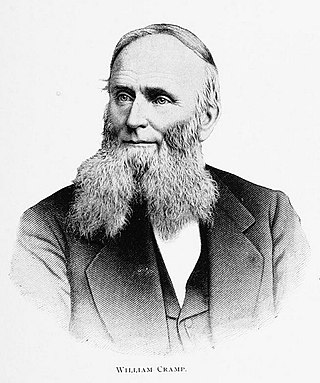
A steamship, often referred to as a steamer, is a type of steam-powered vessel, typically ocean-faring and seaworthy, that is propelled by one or more steam engines that typically move (turn) propellers or paddlewheels. The first steamships came into practical usage during the early 1800s; however, there were exceptions that came before. Steamships usually use the prefix designations of "PS" for paddle steamer or "SS" for screw steamer. As paddle steamers became less common, "SS" is incorrectly assumed by many to stand for "steamship". Ships powered by internal combustion engines use a prefix such as "MV" for motor vessel, so it is not correct to use "SS" for most modern vessels.

William Cramp & Sons Shipbuilding Company was an American shipbuilding company based in Philadelphia, Pennsylvania, founded in 1830 by William Cramp. During its heyday in late 19th century, it was the preeminent American iron shipbuilder.

An ocean liner is a type of passenger ship primarily used for transportation across seas or oceans. Ocean liners may also carry cargo or mail, and may sometimes be used for other purposes. The Queen Mary 2 is the only ocean liner still in service to this day.

The first USS Panther (AD-6), the former SS Venezuela, was an auxiliary cruiser and naval troop transport in the United States Navy. Panther was designated AD-6 in 1920.

The New York Shipbuilding Corporation was an American shipbuilding company that operated from 1899 to 1968, ultimately completing more than 500 vessels for the U.S. Navy, the United States Merchant Marine, the United States Coast Guard, and other maritime concerns. At its peak during World War II, NYSB was the largest and most productive shipyard in the world. Its best-known vessels include the destroyer USS Reuben James (DD-245), the cruiser USS Indianapolis (CA-35), the aircraft carrier USS Kitty Hawk (CV-63), the nuclear-powered cargo ship NS Savannah, and a quartet of cargo-passenger liners nicknamed the 4 Aces.

CP Ships was a large Canadian shipping company established in the 19th century. From the late 1880s until after World War II, the company was Canada's largest operator of Atlantic and Pacific steamships. Many immigrants travelled on CP ships from Europe to Canada. In 1914 the sinking of the Canadian Pacific steamship RMS Empress of Ireland just before World War I became largest maritime disaster in Canadian history. The company provided Canadian Merchant Navy vessels in World Wars I and II. Twelve vessels were lost due to enemy action in World War II, including the RMS Empress of Britain, which was the largest ship ever sunk by a German U-boat.

Ellerman Lines was a UK cargo and passenger shipping company that operated from the late nineteenth century and into the twentieth century. It was founded in the late 19th century, and continued to expand by acquiring smaller shipping lines until it became one of the largest shipping firms in the World. Setbacks occurred through heavy losses to its merchant fleet in the First and Second World Wars but were overcome in each case.

P. Henderson & Company, also known as Paddy Henderson, was a ship owning and management company based in Glasgow, Scotland and operating to Burma and New Zealand. Patrick Henderson started business in Glasgow as a merchant at the age of 25 in 1834. He had three brothers. Two were merchants working for an agent in the Italian port of Leghorn; the third, George, was a sea captain with his own ship.
SS California may refer to the following ships:

RMS Empress of China was an ocean liner built in 1890-1891 by Naval Construction & Armament Co., Barrow, England for Canadian Pacific Steamships (CP). This ship—the first of three CP vessels to be named Empress of China—regularly traversed the trans-Pacific route between the west coast of Canada and the Far East until she struck an underwater reef and sank in Tokyo harbour in 1911.

RMS Empress of India was an ocean liner built in 1890-1891 by Naval Construction & Armaments Co, Barrow-in-Furness, England for Canadian Pacific Steamships. This ship would be the first of two CP vessels to be named Empress of India, and on 28 April 1891, she was the first of many ships named Empress arriving at Vancouver harbor.

The Alaska Steamship Company was formed on August 3, 1894. While it originally set out to ship passengers and fishing products, the Alaska Steamship Company began shipping mining equipment, dog sleds, and cattle at the outbreak of the Klondike Gold Rush of 1897. The company was purchased by the Alaska Syndicate and merged with the Northwestern Steamship Company in 1909, but retained its name, and the fleet was expanded to 18 ships. During World War II, the government took over the company's ships. When the war ended, the company struggled to compete with the new Alaska Highway for passengers and freight. It discontinued passenger service altogether in 1954 and shut down operations in 1971.

The Battle of Río de Oro was a single-ship action fought in August 1914 during the First World War, when HMS Highflyer attacked the German SS Kaiser Wilhelm der Grosse off Río de Oro on the coast of Northwest Africa.

SS Parthia (1870–1956) was an iron-hulled transatlantic ocean liner built for the Cunard Line by William Denny and Brothers in Dumbarton, Scotland. Her sister ships were the Abyssinia and Algeria. Unlike her two sisters, Parthia was smaller, built in a different shipyard and had a slightly different funnel arrangement. The Parthia was retired by Cunard in 1883 and sold to John Elder & Co., who subsequently transferred her to the Guion Line. After serving with the Guion Line and operating on trans-Pacific routes with the Canadian Pacific Railway Company, she was refitted and renamed Victoria.

Steam-powered vessels include steamboats and steamships. Smaller steamboats were developed first. They were replaced by larger steamships which were often ocean-going. Steamships required a change in propulsion technology from sail to paddlewheel to screw to steam turbines. The latter innovation changed the design of vessels to one that could move faster through the water. Engine propulsion changed to steam turbine in the early 20th century. In the latter part of the 20th century, these, in turn, were replaced by gas turbines.
The following index is provided as an overview of and topical guide to Wikipedia's articles on recreational dive sites. The level of coverage may vary:

Recreational dive sites are specific places that recreational scuba divers go to enjoy the underwater environment or for training purposes. They include technical diving sites beyond the range generally accepted for recreational diving. In this context all diving done for recreational purposes is included. Professional diving tends to be done where the job is, and with the exception of diver training and leading groups of recreational divers, does not generally occur at specific sites chosen for their easy access, pleasant conditions or interesting features.













